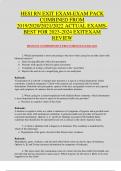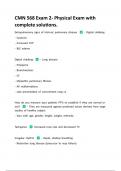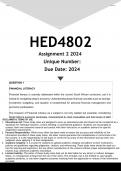HESI RN EXIT EXAM-EXAM PACK
COMBINED FROM
2019/2020/2021/2022 ACTUAL EXAMS-
BEST FOR 2023-2024 EXITEXAM
REVIEW
HESI EXIT COMPREHENSIVE PROCTORED EXAM 2023-2024
1. Which information is most concerning to the nurse when caring for an older client with
bilateral cataracts?
a. States having difficulty with color perception
b. Presents with opacity of the lens upon assessment
c. Complains of seeing a cobweb-type structure in the visual field
d. Reports the need to use a magnifying glass to see small print
Rationale:
Visualization of a cobweb- or hairnet-type structure is a sign of a retinal detachment, which
constitutes a medical emergency. Clients with cataracts are at increased risk for retinal
detachment. Distorted color perception, opacity of the lens, and gradual vision loss are expected
signs and symptoms of cataracts but do not need immediate attention.
2. When caring for a client hospitalized with Guillain-Barré syndrome, which information
is most important for the nurse to report to the primary health care provider?
a. Decrease in cognitive status of the client
Rationale:
A decline in cognitive status in a client is indicative of symptoms of hypoxia and a possible need
to assist the client with mechanical ventilation. A primary health care provider will need to be
contacted immediately. Options A, C, and D are findings associated with Guillain-Barré
syndrome that should also be reported but are not as critical as the client's hypoxic status.
3. A client is admitted with a diagnosis of leukemia. This condition is manifested by
which of the following?
a. Hyperplasia of the gums, elevated white blood count, weakness
Rationale:
Hyperplastic gums, weakness, and elevated white blood count are classic signs of leukemia.
Options A, B, and D state incorrect information for symptoms of leukemia.
4. The nurse enters the examination room of a client who has been told by her health care
provider that she has advanced ovarian cancer. Which response by the nurse is likely to be most
supportive for the client?
, a. "Tell me about what you are feeling right now."
Rationale:
The most therapeutic action for the nurse is to be an active listener and to encourage the client to
explore her feelings. Giving false reassurance or personal suggestions are not therapeutic
communication for the client.
5. A nurse working in the emergency department admits a client with full thickness burns
to 50% of the body. Assessment findings indicate high-pitched wheezing, heart rate of 120
beats/min, and disorientation. Which action should the nurse take first?
a. Prepare to assist with maintaining the airway.
Rationale:
High-pitched wheezing indicates laryngeal stridor, a sign of laryngeal edema associated with
lung injury. Airway management is the first priority of care. Options A, C, and D are all
appropriate interventions in managing the client with a burn but are not as critical as establishing
an airway.
6. The nurse walks into the room and observes the client experiencing a tonic- clonic
seizure. Which intervention should the nurse implement first?
a. Turn the client on the side to aid ventilation.
Rationale:
Maintaining the airway during a seizure is the priority for safety. Options A, B, and C are
contraindicated during a seizure and may cause further injury to the client.
7. Which intervention should be included in the plan of care for a client admitted to the
hospital with ulcerative colitis?
a. Provide a low-residue diet.
Rationale:
A low-residue diet will help decrease symptoms of diarrhea, which are clinical manifestations of
ulcerative colitis.
8. A nurse implements an education program to reduce hospital readmissions for clients
with heart failure. Which statement by the client indicates that teaching has been effective?
a. "I will not take my digoxin if my heart rate is higher than 100 beats/min."
b. "I should weigh myself once a week and report any increases."
c. "It is important to increase my fluid intake whenever possible."
d. "I should report an increase of swelling in my feet or ankles."
Rationale:
An increase in edema indicates worsening right-sided heart failure and should be reported to the
primary health care provider. Digitalis should be held when the heart rate is lower than 60
beats/min. The client with heart failure should weigh himself or herself daily and report a gain of
2 to 3 lb. An increase in fluid can worsen heart failure.
HESI RN EXIT EXAM-EXAM PACKCOMBINED FROM 2019/2020/2021ACTUAL EXAMS-BEST FOR 2022
EXITEXAM REVIEW
, 9. After assessing a 26-year-old client with type 1 diabetes mellitus, which data may
indicate that the client is experiencing chronic complications of diabetes?
a. Blood pressure, 159/98 mm Hg
Rationale:
A blood pressure of 159/98 mm Hg is hypertensive and increases the client's risk for acute
coronary syndrome and/or stroke.
10. When caring for a client with a tracheostomy, which intervention should the nurse
delegate to the unlicensed assistive personnel (UAP)?
a. Take the vital signs and obtain an O2 saturation level.
Rationale:
The nurse may delegate obtaining vital signs and O2 saturation; however, the nurse is
responsible for following up on any reported data.
11. The charge nurse is making assignments for the upcoming shift. Which client is most
appropriate to assign to the practical nurse (PN)?
a. A client with nausea who needs a nasogastric tube inserted
b. A client in hypertensive crisis who needs titration of IV nitroglycerin
c. A newly admitted client who needs to have a plan of care established
d. A client who is ready for discharge who needs discharge teaching
Rationale:
The client mentioned in option A has a need for a skill that is within the scope of practice for the
PN. Titration of an IV drip, establishing care plans, and discharge teaching are within the scope
of practice of a registered nurse (RN) and are not delegated.
12. A nurse performs an initial admission assessment of a 56-year-old client. Which
factor(s) would indicate that the client is at risk for metabolic syndrome? (Select all that apply.)
a. Abdominal obesity
b. Sedentary lifestyle
c. Hispanic or Asian ethnicity
d. Increased triglycerides
Rationale:
Metabolic syndrome is a name for a group of risk factors that increase the risk for coronary
artery disease, type 2 diabetes, and stroke (A, B, D, and E).
13. Which clinical manifestation in the client with hyperthyroidism is most The apical
heart rate of 130 beats/min is a critical finding that could lead to heart failure or other cardiac
disorders. Options A, B, and D are all expected findings that should also be reported but are not
as critical.
a. Apical heart rate of 130 beats/min
Rationale:
HESI RN EXIT EXAM-EXAM PACKCOMBINED FROM 2019/2020/2021ACTUAL EXAMS-BEST
FOR 2022 EXITEXAM REVIEW
, The apical heart rate of 130 beats/min is a critical finding that could lead to heart failure
or other cardiac disorders.
14. The nurse administers atropine sulfate ophthalmic drops preoperatively to the right
eye of a client scheduled for cataract surgery. Which response by the client indicates that the
drug was effective?
a. The right pupil dilates after drop instillation.
Rationale:
Atropine is a mydriatic drug which causes pupil dilation and paralysis in preparation for surgery
or examination.
15. A client with human immunodeficiency virus (HIV) develops a painful blistering skin rash on
the right lateral abdominal area. Which drug should the nurse expect to administer to treat this
condition?
a. Levofloxacin
b. Acyclovir sodium
c. Fluconazole
d. Esomeprazole
Rationale:
The clinical manifestations listed are consistent with herpes zoster (shingles). Acyclovir sodium
is an antiviral used to treat herpes zoster or shingles. Levofloxacin is an antibiotic and may be
used to treat pneumonia or other infections in the HIV client. Fluconazole is an antifungal and is
used to treat candidiasis in the HIV client. Esomeprazole is a protein pump inhibitor used for
gastroesophageal reflux disease.
16. When assessing a 38-year-old client with tuberculosis who is taking rifampin, which finding
would be most important to report to the primary health care provider immediately?
a. Orange-colored urine
b. Potassium level, 4.9 mEq/L
c. Elevated liver enzyme levels
d. Blood urea nitrogen (BUN) level, 12 mg/dL.
Rationale:
Rifampin can cause hepatotoxicity, so elevated liver enzyme levels need to be closely monitored
and reported to the health care provider. Orange discoloration of the urine is an expected side
effect of this medication. The potassium level is normal. A BUN level of 12 mg/dL is within
defined parameters.
17. A client with non-Hodgkin lymphoma has been prescribed cyclophosphamide IV for
therapy. Which assessment finding would need to be reported immediately to the oncologist?
a. Chills, fever, and sore throat
Rationale:
Cyclophosphamide is an immunosuppressive drug used to treat lymphoma and puts the client at
risk for infection. Signs and symptoms of an infection should be reported to the oncologist
immediately.
HESI RN EXIT EXAM-EXAM PACKCOMBINED FROM 2019/2020/2021ACTUAL EXAMS-BEST
FOR 2022 EXITEXAM REVIEW






